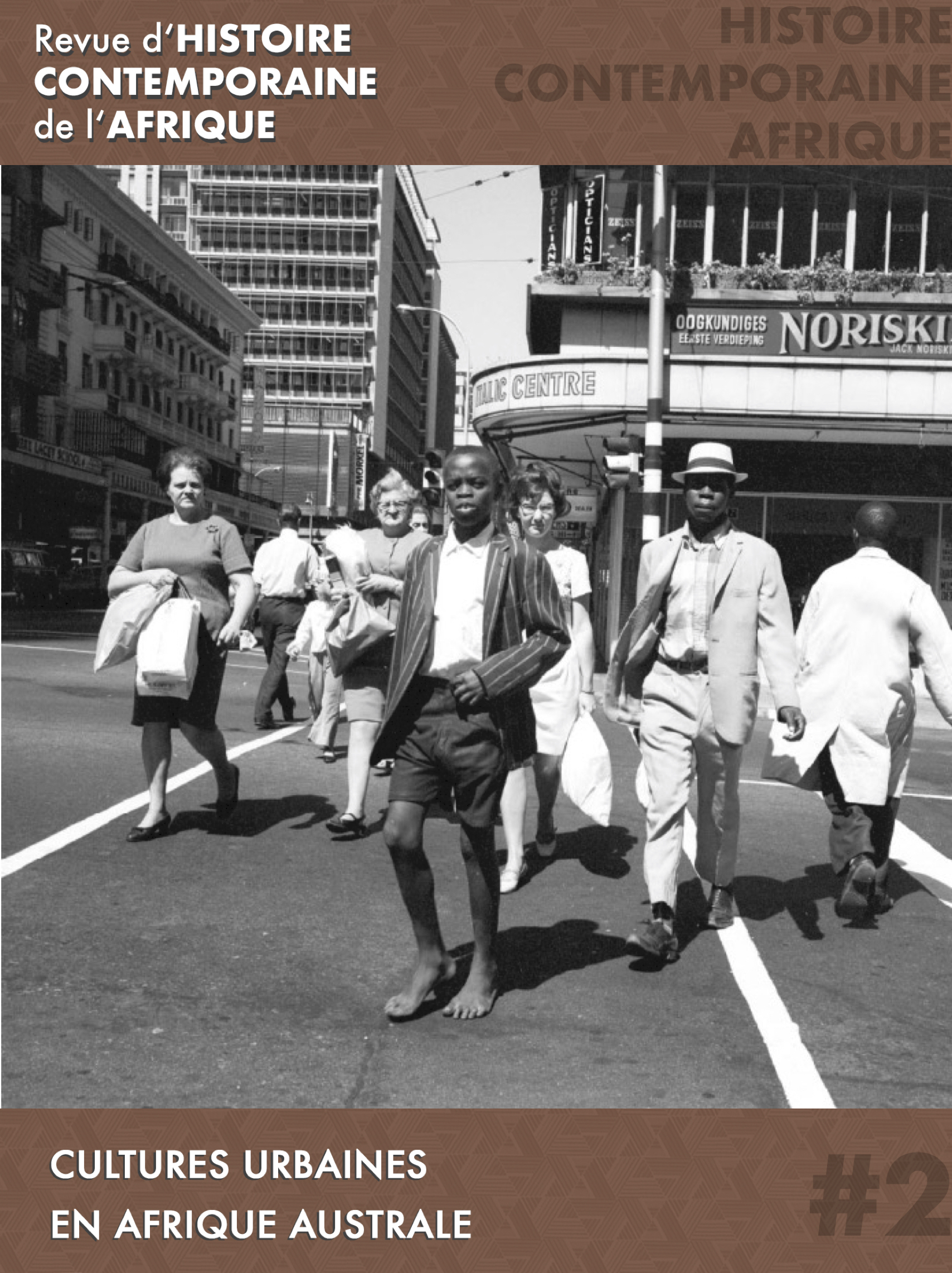Un centre-ville rose
La création d’espaces queer à Hillbrow (Johannesbourg) au temps de l’apartheid
DOI :
https://doi.org/10.51185/journals/rhca.2021.e556Mots-clés :
Johannesbourg, culture urbaine, culture queer, gay, lesbiennes, cruisingRésumé
Johannesbourg, plus grande ville d’Afrique du Sud et cœur économique du pays, possède une riche histoire de culture queer. L’article se concentre sur le quartier de Hillbrow, dans les années 1970 et 1980, à une époque où il est considéré comme le centre gay de Johannesbourg. Il a pour objectif de montrer comment les homosexuels ont façonné, dans ce quartier du centre-ville, une culture urbaine propre, avec la création de clubs et de bars gays ou gay-friendly, avec la multiplication des fêtes privées et la constitution d’espaces publics de « drague » (cruising). Ces processus sont examinés dans le contexte de l’Immorality Amendment Act de 1969 qui criminalise les homosexuels. L’article analyse également la dynamique raciale entre homosexuels noirs et blancs, et la façon dont elle a compliqué la production d’espaces gays et queer dans la ville. Basée sur des archives et des entretiens oraux, cette recherche met en lumière l’importance de Hillbrow en tant qu’« espace sûr » (safe space) pour les personnes queer durant les années d'apartheid.
Traduction française : Gilles Baro, Sophie Dulucq et Camille Evrard.
Références
BANHAM Hugo (2017), « Mapping the Black Queer Geography of Johannesburg’s Lesbian Women through Narrative », PINS (Psychology in Society), 55, en ligne. URL : http://www.scielo.org.za/scielo.php?script=sci_arttext&pid=S1015-60462017000300006 (consulté le 8 août 2021).
BATRA Kanika (2016), « Worlding Sexualities under Apartheid: From Gay Liberation to a Queer Afropolitanism », Postcolonial Studies, 19(1), pp. 37-52.
CAROLIN Andy (2017), « Apartheid’s Immorality Amendment Act and the fiction of heteronormative whiteness », Tydskrif vir Letturkunde, 54(1), en ligne. URL : http://www.scielo.org.za/scielo.php?script=sci_arttext&pid=S0041-476X2017000100007 (consulé le 6 août 2021).
COCK Jacklyn (2003), « Engendering Gay and Lesbian Rights: The Equality Clause in the South African Constitution », Women’s Studies International Forum, 26(1), pp. 35-45.
CONWAY Daniel (2009), « Queering Apartheid: The National Party’s 1987 “Gay Rights” Election Campaign in Hillbrow », Journal of Southern African Studies, 35(4), pp. 849-863.
DUBOW Saul (2014), Apartheid, 1948-1994, United Kingdom, Oxford University Press.
DU PISANI Kobus (2012), « Shifting Sexual Morality? Changing Views on Homosexuality in Afrikaner Society during the 1960s », Historia, 57(2), pp. 182-221.
GEVISSER Mark (1994), « A Different Fight for Freedom: A History of South African Lesbian and Gay Organisation from the 1950s to 1990s », in M. GEVISSER et E. CAMERON (dir.), Defiant Desire: Gay and Lesbian Lives in South Africa, Braamfontein, Ravan Press, pp. 14-88.
GEVISSER Mark (2014), Lost and Found in Johannesburg. A memoir, New York, Farrar, Straus and Giroux.
GEVISSER Mark et CAMERON Edwin (1994), « Defiant Desire », in M. GEVISSER et E. CAMERON (dir.), Defiant Desire: Gay and Lesbian Lives in South Africa, Braamfontein, Ravan Press, pp. 3-13.
HOAD Neville, KAREN Martin et GRAEME Reid (dir.) (2005), Sex and Politics in South Africa, Cape Town, Double Storey Books.
MARCUSE Peter (2016), « Whose Right(s) to what City? », in N. BRENNER, P. MARCUSE et M. MAYER (dir.), Cities for People, Not for Profit: Critical Urban Theory and the Right to the City, Oxon, Routledge, pp. 24-41.
MATHER C. (1987), « Residential Segregation and Johannesburg’s “Locations in the Sky” », South African Geographical Journal, 69(2), pp. 119-128.
MOONEY Katie (2006), « Die Eendstert Euwel » and societal responses to white youth sub-cultural identities on the Witwatersrand, 1930-1964, Thèse de doctorat en histoire, Université du Witwatersrand.
MORRELL Robert (1998), « Of Boys and Men: Masculinity and Gender in Southern African Studies », Journal of Southern African Studies, 24(4), pp. 605-630.
MORRIS Alan (1999), « Race Relations and Racism in a Racially Diverse Inner City Neighbourhood: A Case Study of Hillbrow, Johannesburg », Journal of Southern African Studies, 25(4), pp. 667-694.
MORRIS Alan (1999), Bleakness and Light: Inner-City Transition in Hillbrow, Johannesburg, South Africa, Witwatersrand University Press.
MURRAY Martin J. (2008), Taming the Disorderly City: The Spatial Landscape of Johannesburg after Apartheid, Ithaca and London, Cornell University Press.
NICOL Julia (1991), « Organisation of Lesbian and Gay Activists », Agenda: Empowering Women for Gender Equity, 7(11), pp. 45-46.
REDDY Vasu (1998), « Negotiating Gay Masculinities », Agenda: Empowering Women for Gender Equity, 37, pp. 65-70.
RETIEF Glen (1994), « Keeping Sodom out of the Laager: The Policing of Sexual Minorities in South Africa », in M. GEVISSER et E. CAMERON (dir.), Defiant Desire: Gay and Lesbian Lives in South Africa, Braamfontein, Ravan Press, pp. 99-114.
SHEAR Keith (2013), « At war with the pass laws? Reform and the Policing of White Supremacy in 1940s South Africa », The Historical Journal, 56(1), pp. 205-229.
TABET Paola (2012), « Through the looking glass: sexual-economic exchange », in F. GRANDE OMOKARO et F. REYSOO (dir.), Chic, chèque, choc : transactions autour des corps et stratégies amoureuses contemporaines, Genève, Graduate Institute Publications, pp. 39-51.
Téléchargements
Publiée
Comment citer
Numéro
Rubrique
Licence
Certains droits réservés 2021 Jonathan Botes; Gilles Baro, Sophie Dulucq, Camille Evrard

Ce travail est disponible sous licence Creative Commons Attribution - Pas d’Utilisation Commerciale 4.0 International.





